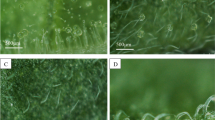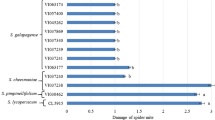Abstract
The whitefly Bemisia tabaci is one of the most important pests of solanaceous crops worldwide, mainly due to its ability to transmit different viruses, including begomoviruses. Tomato severe rugose virus (ToSRV) is the prevalent begomovirus in southeastern and central Brazil, and affects economically important vegetable crops such as tomato and pepper. Here we evaluated 36 pepper accessions comprising four species (Capsicum annuum, C. frutescens, C. chinense and C. baccatum) for ToSRV and B. tabaci resistance, through free-choice and non-choice tests. The accessions IAC-1544 (C. frutescens), IAC-1545 and 1549 (C. chinense), IAC-1551, 1566 and 1579 (C. annuum) were infected by ToSRV but did not show any symptoms. Among them, IAC-1544, IAC-1545, IAC-1551 and IAC-1579 displayed significant differences in whitefly egg-laying preference in the free-choice test. In the non-choice test, IAC-1544, IAC-1545 and IAC-1579 displayed similar reaction, being unattractive to the insects and exhibiting reduced oviposition rates. Low survival of nymphs and high mortality were observed in accessions IAC-1544, IAC-1545, IAC-1549, IAC-1551, IAC-1566 and IAC-1579, suggesting the involvement of antibiosis mechanisms. The accessions IAC-1544, IAC-1545 and IAC-1579 could be classified as good sources of resistance to both ToSRV and B. tabaci.

Similar content being viewed by others
References
Baldin ELL, Beneduzzi RA (2010) Characterization of antibiosis and antixenosis to the silverleaf whitefly Bemisia tabaci B biotype (Hemiptera: Aleyrodidae) in several squash varieties. Journal of Pest Science 83:223–229
Ballina-Gómez H, Latournerie-Moreno L, Ruiz-Sánchez E, Pérez-Gutiérrez A, Rosado-Lugo G (2013) Morphological characterization of Capsicum annuum L. accessions from southern Mexico and their response to the Bemisia tabaci - begomovirus complex. Chilean Journal of Agricultural Research 73:329–338
Barbosa LF, Marubayashi JM, De Marchi BR, Yuki VA, Pavan MA, Moriones E, Navas-Castillo J, Krause-Sakate R (2014) Indigenous American species of the Bemisia tabaci complex are still widespread in the Americas. Pest Management Science 70:1440–1445
Barbosa LF, Yuki VA, Marubayashi JM, De Marchi B, Perini FL, Pavan MA, Barros DR, Ghanim M, Moriones E, Navas-Castillo J, Krause-Sakate R (2015) First report of Bemisia tabaci Mediterranean (Q biotype) species in Brazil. Pest Management Science 71:501–504
Bezerra-Agasie IC, Ferreira GB, Avila AC, Inoue-Nagata AK (2006) First report of Tomato severe rugose virus in chili pepper in Brazil. Plant Disease 90:114
Boiça Júnior AL, Campos ZR, Lourenção AL, Campos AR (2007) Adult attractiveness and oviposition preference of Bemisia tabaci (Genn.) (Homoptera: Aleyrodidae) B-biotype in cotton genotypes. Scientia Agricola 64:147–151
Boykin LM, De Barro PJ (2014) A practical guide to identifying members of the Bemisia tabaci species complex and other morphologically identical species. Frontiers in Ecology and Evolution 2:45
Chen W, Hasegawa DDK, Kaur N, Kliot A, Pinheiro PV, Luan J, Stensmyr MC, Zheng Y, Liu W, Sun H, Xu Y, Luo Y, Kruse A, Yang X, Kontsedalov S, Lebedev G, Fisher TW, Nelson DR, Hunter WB, Brown JK, Jander G, Cilia M, Douglas AE, Ghanin M, Simmons AM, Wintermantel WM, Ling KS, Fei Z (2016) The draft genome of whitefly Bemisia tabaci MEAM1, a global crop pest, provides novel insights into virus transmission, host adaptation, and insecticide resistance. BMC Biology 14:110
Chermenskaya TD, Petrova MO, Savelieva EI (2009) Laboratory and field evaluation of biological active substances of plant origin against greenhouse whitefly, Trialeurodes vaporariorum Westw. (Homoptera: Aleyrodidae). Archives of Phytopathology and Plant Protection 42:864–873
De Barro PJ, Liu S-S, Boykin LM, Dinsdale AB (2010) Bemisia tabaci: a statement of species status. Annual Review of Entomology 56:1–19
Dinsdale AB, Cook L, Riginos C, Buckley Y, De Barro PJ (2010) Refined global analysis of Bemisia tabaci (Gennadius) (Hemiptera: Sternorrhyncha: Aleyrodidea): mitochondrial cytochrome oxidase 1 to identify species level genetic boundaries. Annals of the Entomological Society of America 103:196–208
Doyle JJ, Doyle JL. (1987) A rapid DNA isolation procedure for small quantities of fresh leaf tissue. Phytochemical Bulletin, 19:11-15.
Emden H (2002) Mechanisms of resistance: antixenosis, antibiosis, tolerance, nutrition. In: Pimentel D (ed) Encyclopedia of Pest Management. Marcel Dekker, Ithaca, pp 483–492
Fernandes FR, Albuquerque LC, Giordano LB, Boiteux LS, Avila AC, Inoue-Nagata AK (2008) Diversity and prevalence of Brazilian bipartite begomovirus species associated to tomatoes. Virus Genes 36:251–258
Firdaus S, Van Heusden A, Harpenas A, Supena EDJ, Visser RGF, Vosman B (2011) Identification of silverleaf whitefly resistance in pepper. Plant Breeding 130:708–714
Firdaus S, Van Heusden AW, Hidayati N, Supena EDJ, Visser RGF, Vosman B (2012) Resistance to Bemisia tabaci in tomato wild relatives. Euphytica 187:31–45
Frohlich DR, Torres-Jerez I, Bedford ID, Markham PG, Brown JK (1999) A phylogeographical analysis of the Bemisia tabaci species complex based on mitochondrial DNA markers. Molecular Ecology 8:1683–1691
Gilbertson RL, Batuman O, Webster CG, Adkins S (2015) Role of the insect supervectors Bemisia tabaci and Frankliniella occidentalis in the emergence and global spread of plant viruses. Annual Review of Virology 2:67–93
Horowitz AR, Ishaaya I (2014) Dynamics of biotypes B and Q of the whitefly Bemisia tabaci and its impact on insecticide resistance. Pest Management Science 70:1568–1572
Horowitz AR, Kontsedalov S, Khasdan V, Ishaaya I (2005) Biotypes B and Q of Bemisia tabaci and their relevance to neonicotinoid and pyriproxyfen resistance. Archives of Insect Biochemistry and Physiology 58:216–225
Inoue-Nagata AK, Albuquerque LC, Rocha WB, Nagata T (2004) A simple method for cloning the complete begomovirus genome using the bacteriophage φ29 DNA polymerase. Journal of Virological Methods 116:209–211
Inoue-Nagata AK, Carvalho CM, Zerbini FM, Rezende JAM, Krause-Sakate R, Nagata T (2016) Vírus transmitidos por moscas-brancas no Brasil: vetores, principais doenças e manejo. Revisão Anual de Patologia de Plantas 24:1–23
Kogan M, Ortman EF (1978) Antixenosis: a new term proposed to define Painter's "nonpreference" modality of resistance. Bulletin of the Entomological Society of America 24:175–176
Liu TX, Stansly PA (1995) Oviposition by Bemisia argentifolii (Homoptera, Aleyrodidae) on tomato - effects of leaf factors and insecticide residues. Journal of Economic Entomology 88:992–997
Lourenção AL, Nagai H (1994) Surtos populacionais de Bemisia tabaci no Estado de São Paulo. Bragantia 53:53–59
Marubayashi JM, Yuki VA, Rocha KCG, Mituti T, Pelegrinotti FM, Ferreira FZ, Moura MF, Navas-Castillo J, Moriones E, Pavan MA, Krause-Sakate R (2013) At least two indigenous species of the Bemisia tabaci complex are present in Brazil. Journal of Applied Entomology 137:113–121
Navas-Castillo J, Fiallo-Olivé E, Sánchez-Campos S (2011) Emerging virus diseases transmitted by whiteflies. Annual Review of Phytopathology 49:219–248
Nomikou M, Janssen A, Sabelis MW (2003) Herbivore host plant selection: whitefly learns to avoid host plants that harbor predators of her offspring. Oecologia 136:484–488
Nozaki DN, Krause-Sakate R, Hasegawa JM, Cezar MA, Dziuba PH, Pavan MA (2006) First report of Tomato severe rugose virus infecting pepper plants in Brazil. Fitopatologia Brasileira 31:321
Oriani MAG, Vendramim JD (2010) Influence of trichomes on attractiveness and ovipositional preference of Bemisia tabaci (Genn.) B biotype (Hemiptera: Aleyrodidae) on tomato genotypes. Neotropical Entomology 39:1002–1007
Painter RH (1958) Resistance of plants to insects. Annual Review of Entomology 3:267–290
Panda N, Khush GA (1995) Host plant resistance to insects. CAB International, Wallingford
Rocha KC, Krause-Sakate R, Pavan MA, Kobori RF, Gioria R, Yuki VA (2012) Avaliação de danos causados pelo Tomato severe rugose virus (ToSRV) em cultivares de pimentão. Summa Phytopathologica 38:87–89
Rodríguez-López MJ, Garzo E, Bonani JP, Fernandez-Munoz R, Moriones E, Fereres A (2012) Acylsucrose-producing tomato plants forces Bemisia tabaci to shift its preferred settling and feeding site. PLoS One 7:e33064
Rojas MR, Gilbertson RL, Russell DR, Maxwell DP (1993) Use of degenerate primers in the polymerase chain reaction to detect whitefly-transmitted geminiviruses. Plant Disease 77:340–347
SAS Institute Inc. (2008). SAS/STAT® 9.2 User’s Guide. Cary, NC: SAS Institute Inc.
Smith CM (2005) Plant resistance to arthropods: molecular and conventional approaches. Springer Science, Berlin
Sun D-B, Liu Y-Q, Qin L, Xu J, Li FF, Liu SS (2013) Competitive displacement between two invasive whiteflies: insecticide application and host plant effects. Bulletin of Entomological Research 103:344–353
Walsh PS, Metzger DA, Higuchi R (1991) Chelex 100 as a medium for simple extraction of DNA for PCR-based typing from forensic material. BioTechniques 10:506–513
Winer BJ, Brown DR, Michels KM (1971) Statistical principles in experimental design. McGraw-Hill, New York
Acknowledgments
This project was partially funded by FAPESP grant 2012/51771-4 to RKS. KFCP was the recipient of a CAPES fellowship. ELLB, MAP and RKS are CNPq research fellows.
Author information
Authors and Affiliations
Corresponding author
Additional information
Section Editor: F. Murilo Zerbini
Rights and permissions
About this article
Cite this article
Pantoja, K.F.C., Rocha, K.C.G., Melo, A.M.T. et al. Identification of Capsicum accessions tolerant to Tomato severe rugose virus and resistant to Bemisia tabaci Middle East-Asia Minor 1 (MEAM1). Trop. plant pathol. 43, 138–145 (2018). https://doi.org/10.1007/s40858-018-0212-6
Received:
Accepted:
Published:
Issue Date:
DOI: https://doi.org/10.1007/s40858-018-0212-6




